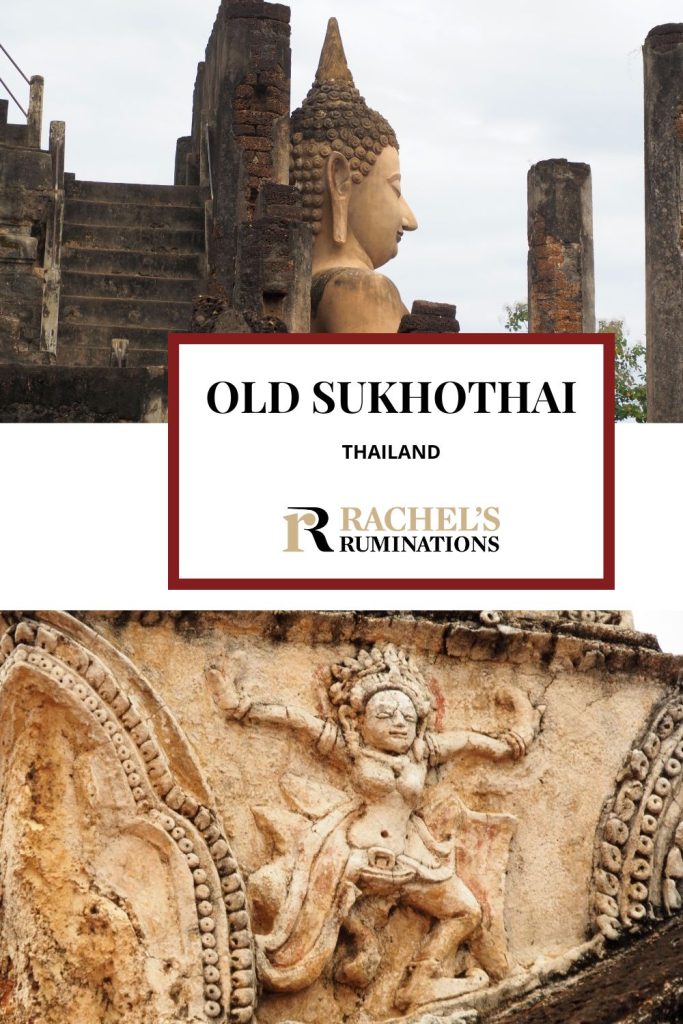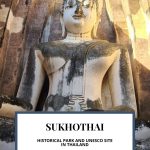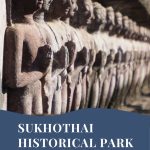Sukhothai Historical Park in Thailand
A standard stop on a Thailand itinerary is to spend a day at Ayutthaya. This 14th-18th-century city was once the capital of Thailand – or Siam as it was then called. What remains is a UNESCO-designated collection of 41 abandoned Buddhist temples and monasteries, some in ruins, some more or less intact. It’s an evocative place, one of the most-visited historic sites in Thailand, and easy to reach from Bangkok.
Disclosure: This article contains affiliate links. If you make a purchase through one of these links, I will receive a small commission. This will not affect your price.
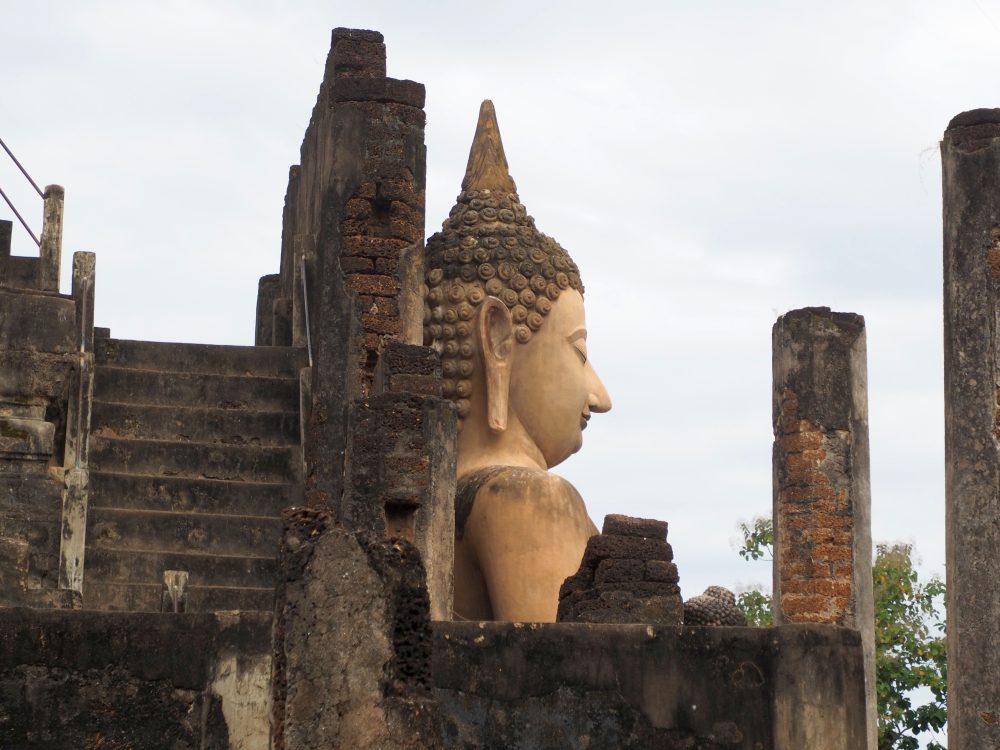
There’s another evocative former capital city worth visiting, however: Sukhothai. Like Ayutthaya, Sukhothai is a UNESCO World Heritage site: an abandoned city of temples and monasteries. The difference, though, is that this was the capital of the first kingdom of Siam, before Ayutthaya, dating from the early 13th century into the 14th century. As you visit Ayutthaya, you’ll hear mention of the “Sukhothai” style in architecture and also in depictions of the Buddha. Sukhothai is where these depictions developed.
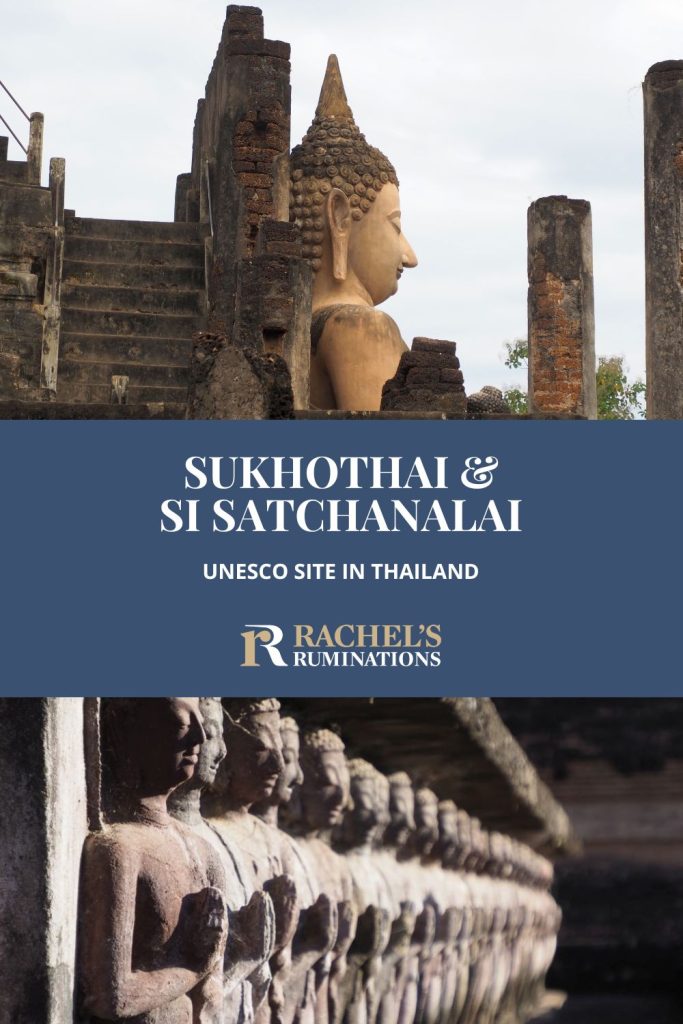
The “Historic Town of Sukhothai and Associated Historic Towns” UNESCO designation includes three separate national parks:
- Sukhothai: the main administrative and royal center of the Kingdom of Siam
- Si Satchanalai: a center of ceramic production
- Kamphaeng Phet: a military outpost.
The largest and easiest to visit is the Historical Park of Sukhothai itself, which covers 70 square kilometers (27 sq. mi.). The other two are smaller: Si Satchanalai is 45 square kilometers (17 sq. mi.) and Kamphaeng Phet is only 338 hectares (1.3 sq. mi.).
The History of Sukhothai
Sukhothai got its start as a minor trading center when it was part of the Khmer Empire. It gained independence from the Khmers in a revolt in 1238. The kingdom of Sukhothai expanded and its power became centralized as a monarchy.
The most famous of Sukhothai’s kings was Ram Khamhaeng the Great, the third king of the new Phra Ruang dynasty, who ruled from 1279-1298. It was under his rule that the production of ceramics for export became so important. He also gets the credit for introducing Theravada Buddhism to Sukhothai, which may or may not be true, but he certainly encouraged its spread. He is also credited with inventing an alphabet that has since evolved into the alphabet used in Thailand today.
Once Ram Khamhaeng died, Sukhothai began to lose power and lose territory as states broke away from the kingdom. In 1349, the Ayutthaya kingdom conquered Sukhothai. It became a vassal state and eventually it became part of the Ayutthaya kingdom in the 15th century.
In the 16th century, the Burmese conquered Ayutthaya, though it wasn’t long before it gained its freedom again in the Burmese-Siamese War (1584-1593). Once victory was assured, the new king of Siam forced the residents of Sukhothai and many other towns to move closer to Ayutthaya. The Sukhothai temples and monasteries were left to decay.

Sukhothai UNESCO site
With only two days to see the three parts of the UNESCO site, I chose to see the main one – Sukhothai Historical Park – and the second-largest, Si Satchanalai, located about an hour’s drive away. Each took a full day. Fortunately I was accompanied by a wonderful guide named Weerapong Kamduang, nicknamed Ball. Ball knows everything about Thai history, art and architecture, and was happy to answer my constant questions. For full disclosure, I paid my own accommodation and transportation, but the Tourism Authority of Thailand‘s Sukhothai office sponsored Ball’s fees for me.
Sukhothai Historical Park
We saw all of the highlights of Sukhothai, plus some more obscure sights in order to get a clear picture of the former glory of this old city. The temples are set quite far apart – though they don’t look so far in the map provided to visitors – so we hired bikes just outside the entrance to get from place to place within the park.
But first, some definitions
What is a prang?
A prang (also called a prasad) is a tower of sorts, usually with a gradually narrowing top. Often prangs are very tall with seven levels. If it looks like a corncob, it’s in Khmer style. Prangs were meant to represent Mount Meru, a mythical mountain considered to be at the center of the physical and spiritual universe. Later ones tapered more to become narrower at the top.
Prangs have a religious function, usually housing some sort of relic of the Buddha or important Buddhist monks. They are sometimes used as funerary monuments for important monks or kings. Prangs usually have space inside where shrines house one or more Buddha images.
What is a chedi?
A chedi serves a similar function to a prang, but I generally heard this term used when the structure tapered to a long narrow point at the top. They are often much smaller than prangs, and often surround a prang or are arranged in clusters. Many of them aren’t big enough to have a shrine inside, but are used as reliquaries or hold the ashes of important monks.
What is a stupa?
A stupa serves the same function as a prang or chedi, but you tend to hear the word “stupa” less often than chedi or prang in Thailand. It seems to be a more general word than the others.
So what’s the difference between a stupa, a prang and a chedi?
Ball explained to me that prangs, chedis and stupas are basically the same thing but with different design traditions. Generally I noticed guides using the term “prang” for rounded ones and “chedi” for smaller pointed ones, but these terms are vague. “Stupa” seems to be the most general term, used for any size or shape. In the Ayutthaya period some were more bell-shaped, while some stupas were built in a sort of pyramidal shape with indented stepped corners. Khmer stupas were made of stone while Sukhothai and Ayutthaya period ones were often made of brick covered with stucco. In any case, they all serve similar religious functions.
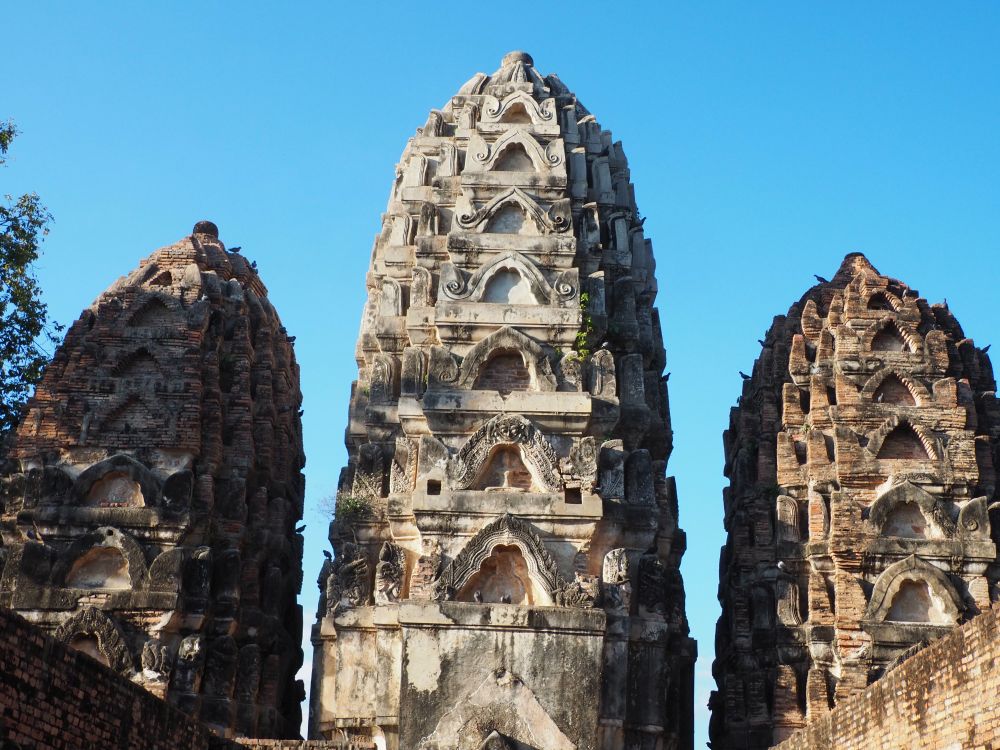
If you’re going to be in Bangkok, you might also enjoy these articles:
So now we can move on to what to see at Sukhothai:
Ta Pha Daeng Shrine
Our first stop was Ta Pha Daeng Shrine. A strange-looking rectangle of large, heavy blocks of laterite stone, it looks more like a defensive structure than a shrine. And indeed, it did duty as both. It’s one of the oldest structures at Sukhothai, dating to the period of Khmer rule and built in a Khmer style.
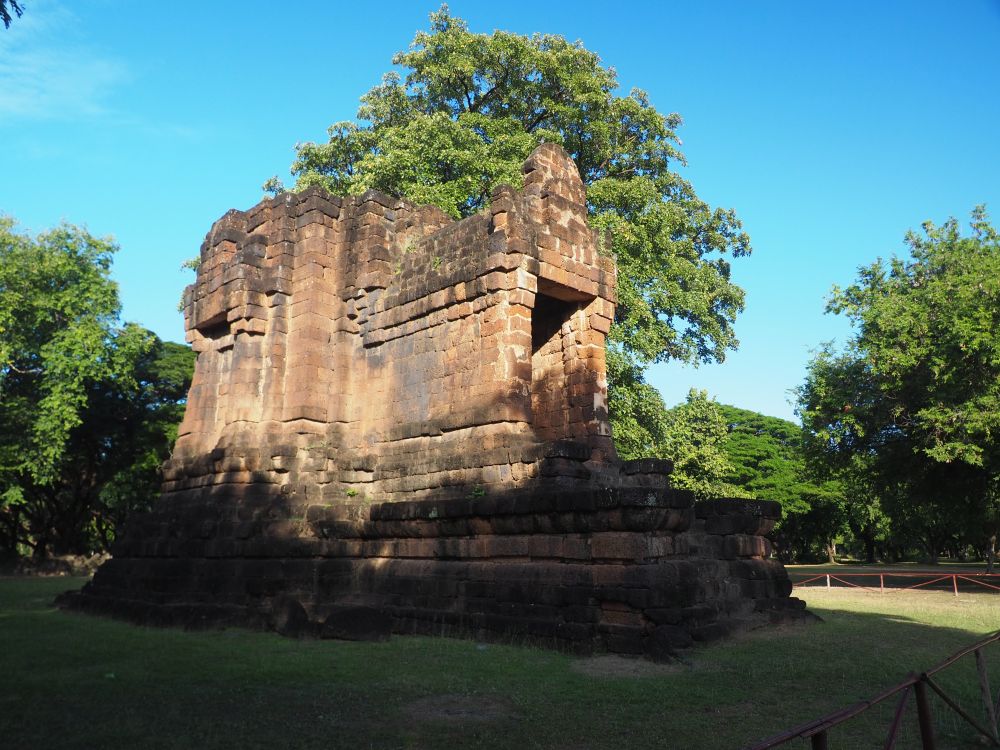
Wat Phra Phai Luang
Next we stopped at Wat Phra Phai Luang, just outside the square double moat that encloses most of the temples. It would once have included a temple with three prangs and a hall. Today the remains of the three prangs are visible and are in different states of decomposition. This temple has its own moat, separate from the larger double moat around the core of the park.
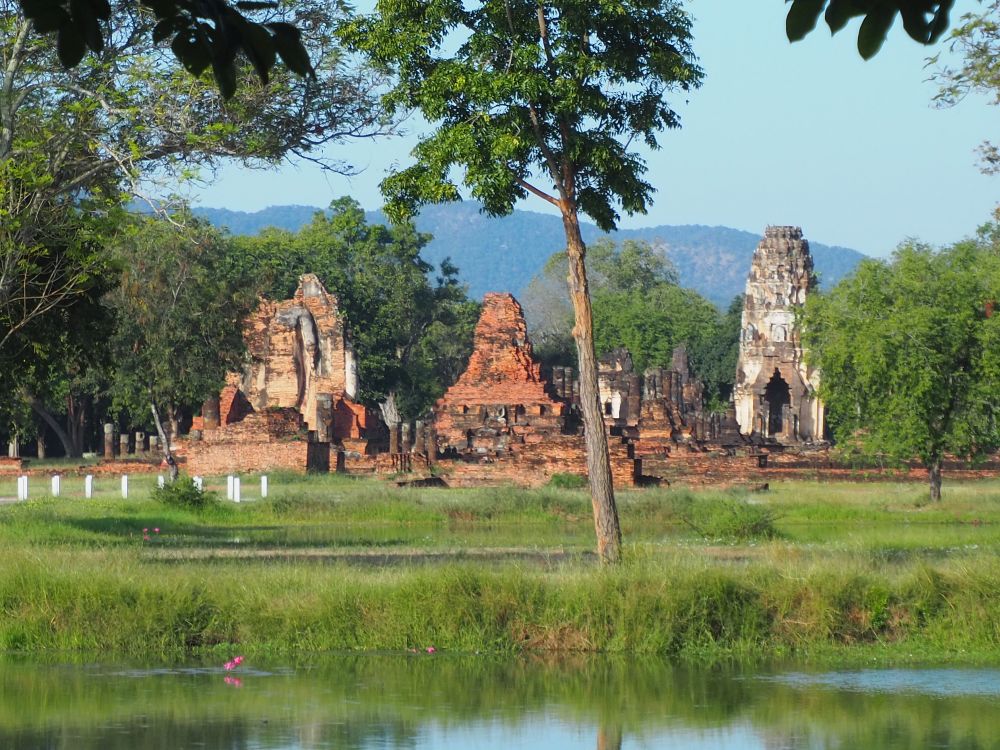
Kilns
Just outside the moat that surrounds Wat Phra Phai Luang are a series of kilns. Not much remains of them, though the best-preserved have had modern roofs placed over them. The kilns were about nine meters long with curved forms and large chimneys. While the structures themselves were rather underwhelming, it was surprising to find bits of pottery just lying around the ground, some of it decorated. Apparently the ceramics produced here, while not fine china, were in demand far and wide, even into China.
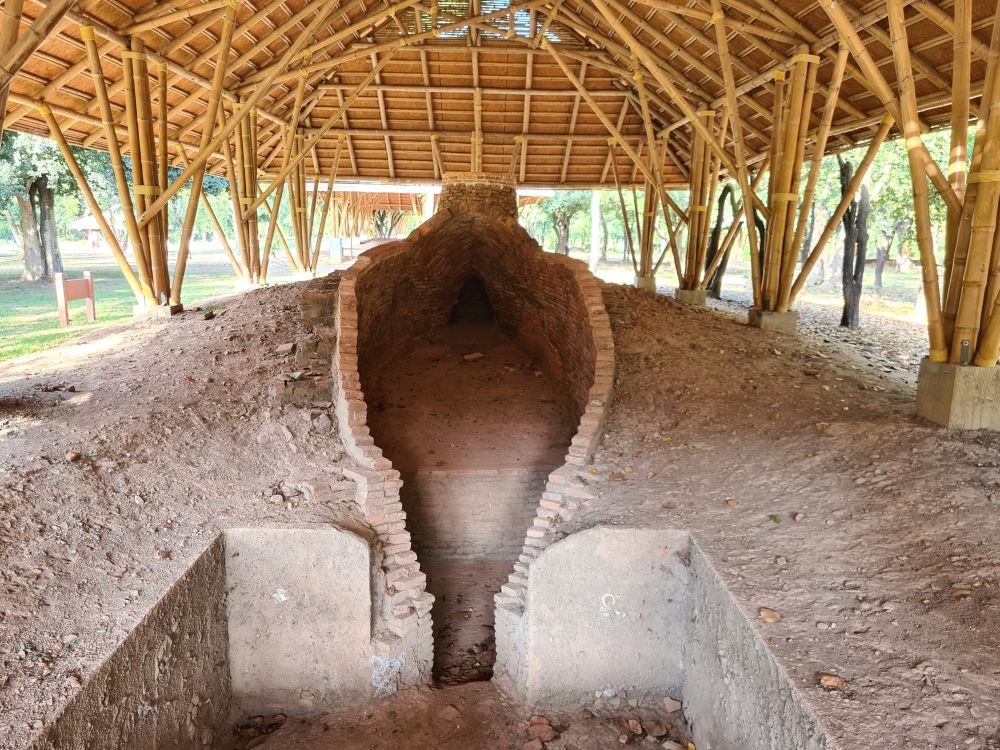
Wat Si Chum
At first glance, Wat Si Chum seems like a simple rectangular building. As you near it, walking up the central path, it becomes clear that this rectangle houses a Buddha figure – a giant Buddha statue that is partly visible through the narrow opening of the temple. The very close-fitting walls would have once had a roof.
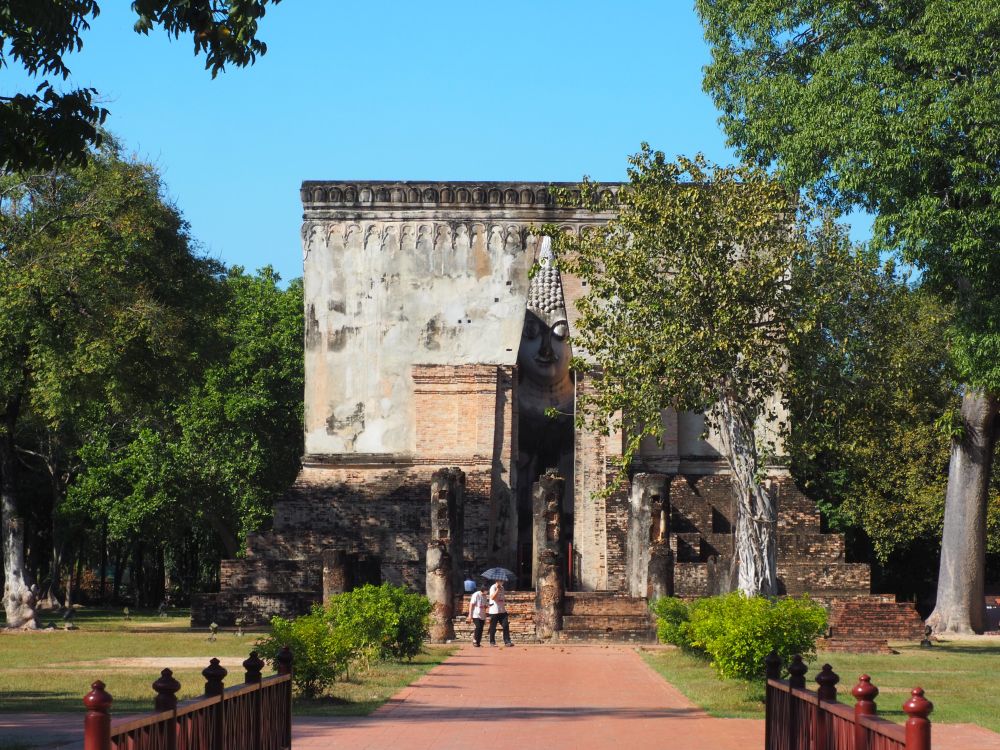
This Buddha statue, called Phra Achana, is in a typical Sukhothai style: a flame shape on its head, long fingers, tightly curled hair, an oval face with a slight smile and high arched eyebrows, and an almost womanly posture with wide shoulders and a small waist. The pose is called “Subduing Mara.” It’s a lovely statue, and makes a strong impression as it peers out of the eastward-facing opening.
What is the Subduing Mara pose about?
This quite common pose is also sometimes called “Calling the Earth to Witness.” It represents a story about the Buddha at a point when he was near achieving Enlightenment. The demon of illusion, Mara, tried to lead the Buddha off the path to Enlightenment. Buddha, after meditating, overcame the temptations that Mara had sent. He called the Earth Goddess to show that he had achieved Enlightment. She, in turn, called up flood waters that swept the demon away. The Buddha’s posture here is a meditating position, with the right hand down – its palm points toward the Buddha while its fingers point downward to the earth.
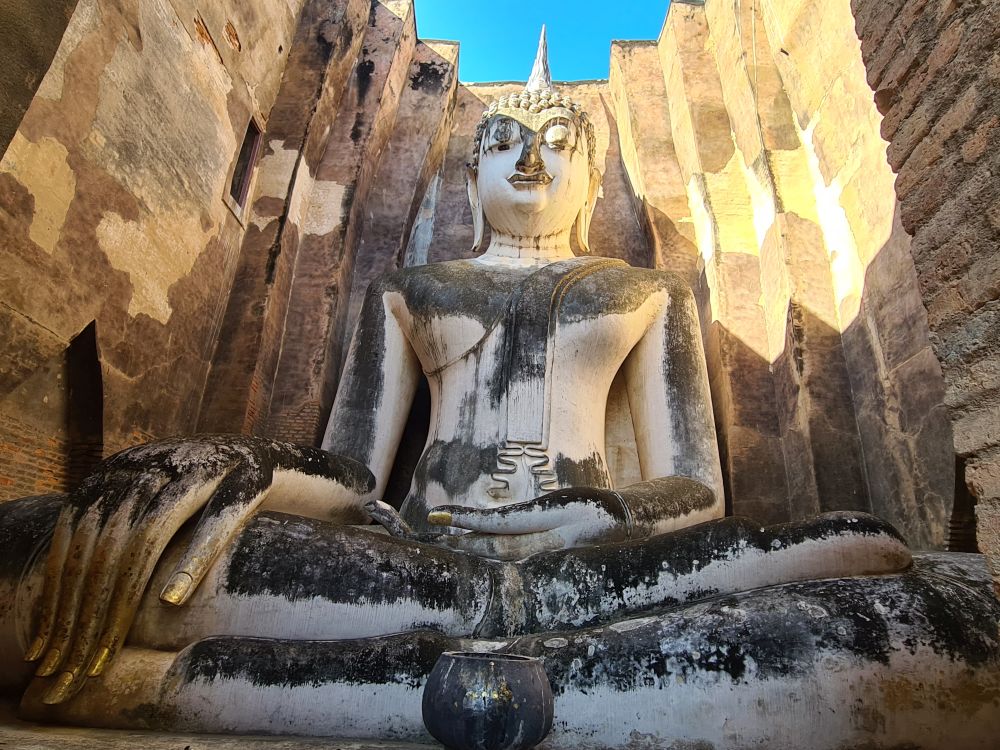
Wat Saphan Hin
After biking a distance away from the center of the park, we arrived at Wat Saphan Hin. Dismounting at the bottom of a hill, we climbed up to the top, about 300 meters (985 feet), partly walking on a wide but ruined wall leading up. On the way we passed a small chedi with a lotus top. At the top are the ruins of a small monastery and a standing Buddha. It looks small from the bottom but, obviously, much bigger close up.
This standing Buddha is also in a classic Sukhothai style with the flame-shaped aureole, the curled hair and that same oval face with a slight smile. His right hand extends forward, palm out, a position called Abhaya Mudra.
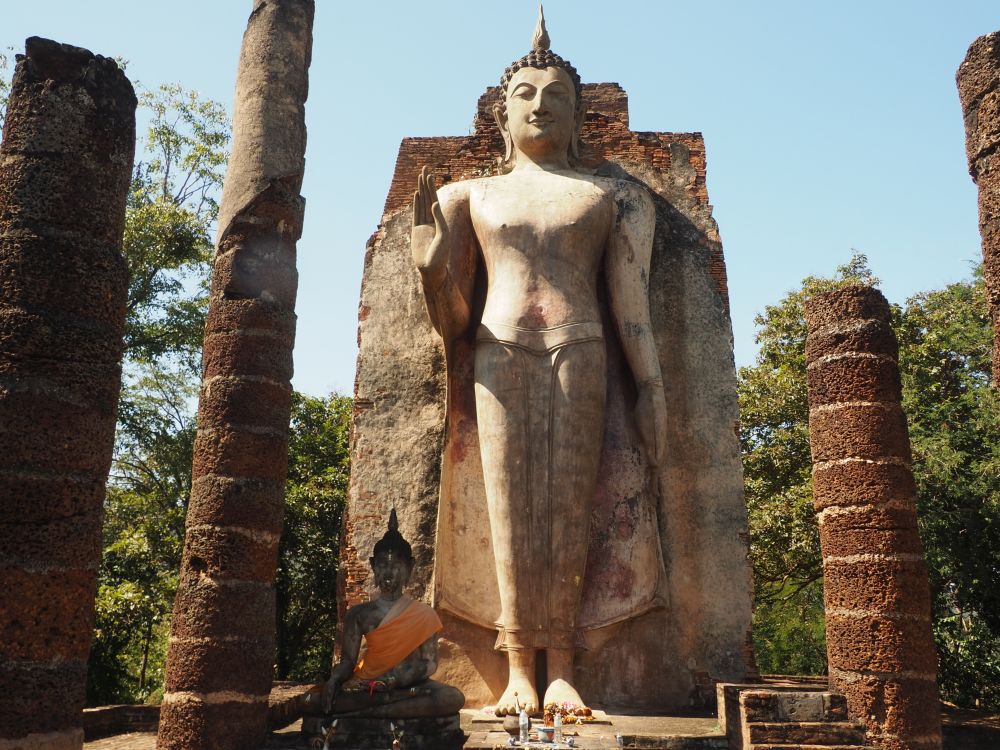
What does the Abhaya Mudra pose mean?
This pose represents dispelling fear or reassurance and can be shown on either a seated or standing Buddha. It comes from a story in which the Buddha was attacked by an elephant but stopped the attack with this gesture.
From the statue you get a wide view of the green flatness of this part of Thailand.
Reservoir
We took a short stop at a reservoir, which, in its day, provided water to the people of Sukhothai. There’s not much to see here but a pretty lake and the modern dike that holds the water in.
Ramkhamhaeng National Museum
This is a pleasant little museum, partly because of the air conditioning, and partly because it is a good place to understand the background of what you’re seeing at Sukhothai. It has well-displayed pieces taken from the temples outside, but also some from the region’s earlier history and the Ayutthaya period. What I found quite useful was the small models of the various kinds of prangs, stupas and ordination and ceremonial halls. It helped me get them all straight in my head. It might have been wiser to go there first, before seeing any of the Sukhothai temple complexes.
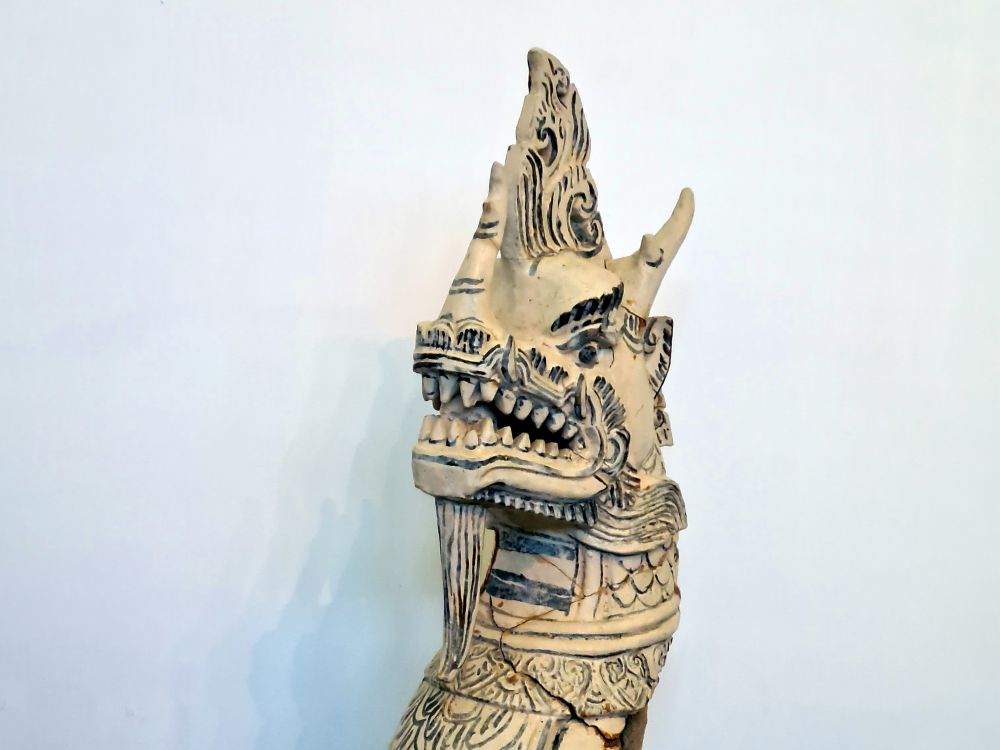
Wat Mahathat
Wat Mahathat is generally considered the main event at Sukhothai. And, yes, it does have the same name as the Ayutthaya-era temple on the grounds of the Grand Palace in Bangkok. It’s a complex of structures almost right in the middle of the square island created by the double moat. Besides being the biggest complex in the park, it also has more detail than many of the temples, at least in part. Some elements have degraded down to the underlying brick, but some parts still have the decorative original details. Notice as well the intricate stone work up high around the side of each stupa, and the row of praying monks at the base.
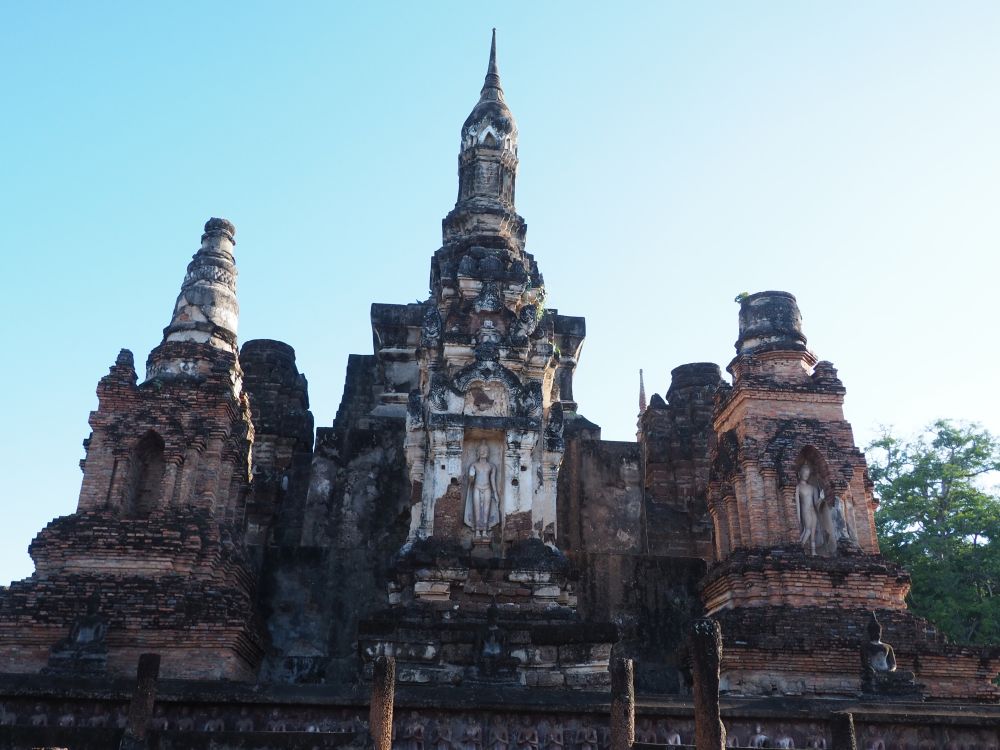
Look for the Standing Buddha bas-reliefs on the sides of the central stupa. You’ll also see a large Sitting Buddha (Abhaya Mudra pose) and a Standing Buddha partly inside walls. This Standing Buddha is unusual in that it’s a Sukhothai-style Buddha otherwise, but it wears a cape and has both arms hanging by its sides.
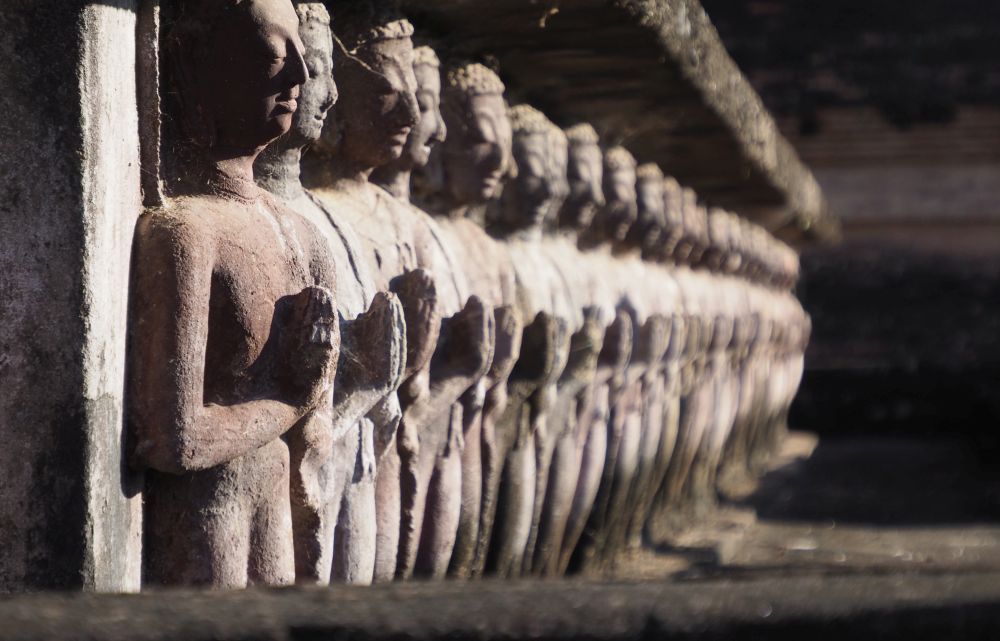
From Wat Mahathat you’ll get some very picturesque views across an artificial lake of a temple called Wat Sa Si. Also nearby is the King Ramkhamhaeng Monument in the middle of a prettily-manicured square. It’s a modern image of the most important king of Sukhothai’s heyday.
Wat Si Sawai
The three prangs on this temple are in remarkably good repair given their age. Originally Khmer, they were restored later in Sukhothai style.
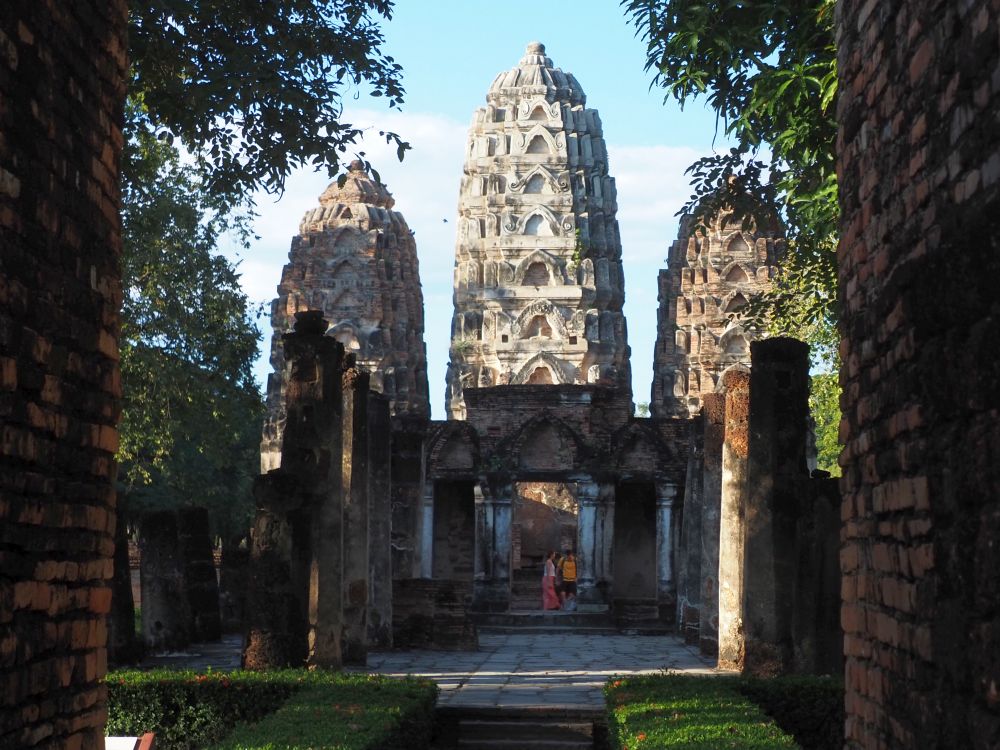
What I’ve described above took us most of the day to see, with a stop for lunch, of course. If you’re going to walk rather than ride bikes, the minimum you should make sure to see are the museum and Wat Mahathat.
Click on the image below to see some multi-day tours of Thailand, some of which include a stop at Sukhothai:
Si Satchanalai Historical Park
On my second day, Ball and I traveled by taxi about an hour north to get to Si Satchanalai. Of the two remaining parts of the UNESCO site, I chose Si Satchanalai based on Ball’s recommendation. Since both Si Satchanalai and Kamphaeng Phet are an hour away from Sukhothai, but in different directions, it wouldn’t be easy to do both in a single day. Si Satchanalai is larger and has more to see.
In general, the architectural styles of the temple complexes at Si Satchanalai are different from those at Sukhothai. Here you’ll see more use of laterite stone, for one thing, and more influences from more different places. What I mean by that is that the stupas come in more different shapes, each carrying Indian, Lankan, Khmer, Ayutthayan and/or Sukhothai influences. Many were changed over the centuries with, for example, an Ayutthayan structure superimposed on top of an older Khmer structure.
The layout of Si Satchanalai Historic Park is less regular than at Sukhothai, though, like Sukhothai, there is a central square that encloses some of the temples. In this case the square is formed by a wall rather than a double moat. Many other temples are scattered outside the square.
If you like what you’re reading, please help me out by buying me a cuppa tea!
Wat Chom Chuen Archeological Site Museum
Unlike the museum at Sukhothai, this museum has few actual objects on display. Nevertheless, it’s worth a quick visit. Informational boards explain the history of the site, and the museum also encompasses part of what was once a burial ground that predates the city of Si Satchanalai by centuries. It’s been preserved in an unusual way: the remains lie in their original location, but with the earth excavated around them. That gives a clear illustration of how this burial ground was used over centuries – the graves are at different depths and oriented in different ways. Walkways allow visitors to view the graves from above.
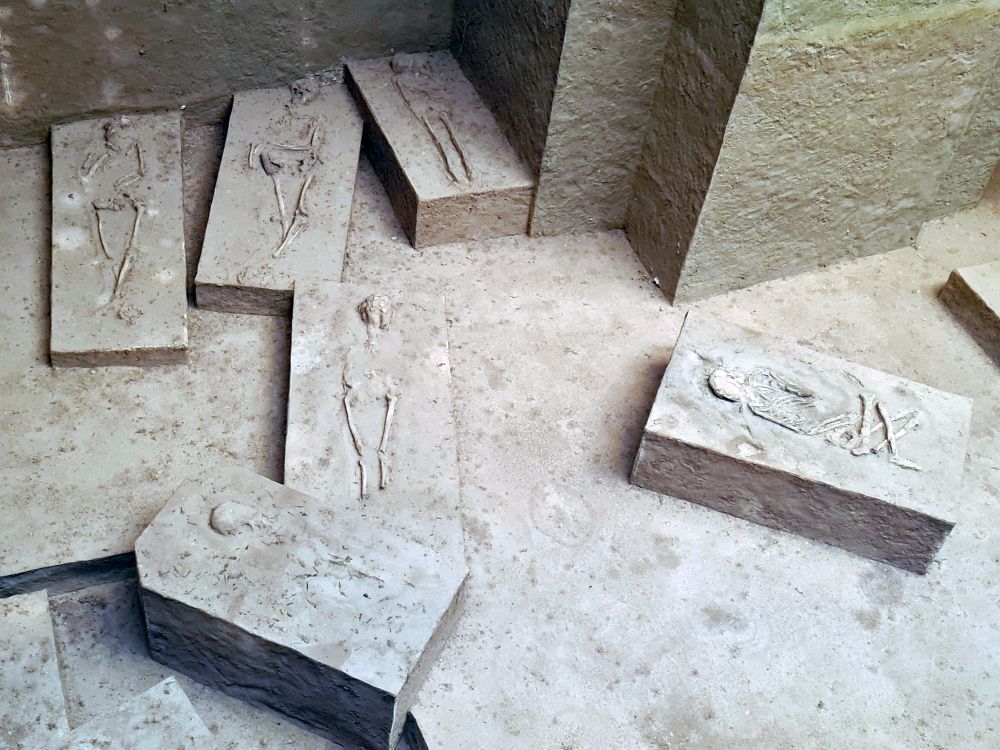
Wat Phra Si Ratana Mahathat Chaliang
This temple complex is an impressive sight particularly because of the tall and intact prang. The rows of columns and the area surrounded by a low laterite wall were once an assembly hall. The columns lead quite grandly to a seated Buddha in Subduing Mara pose, backed by the tall and ornate prang. Notice, as you enter the complex, the wonderful stucco decorations on the entrance that clearly reflect a Hindu influence.
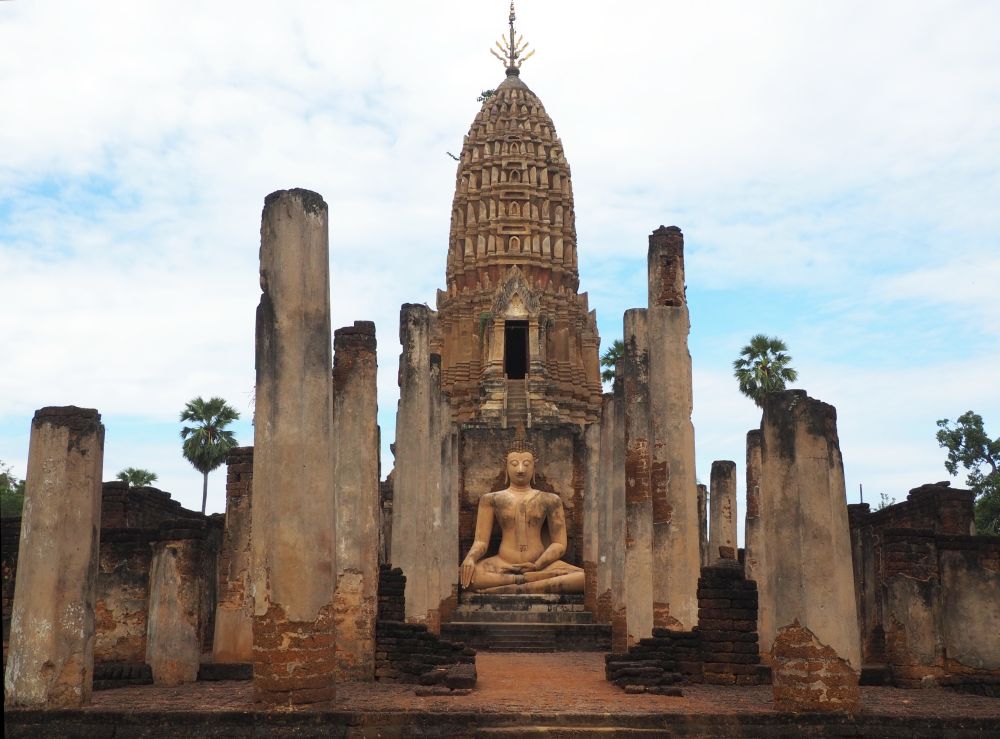
Climb the steep stairs up to the shrine inside the prang and you’ll see an example of how these temples were modified and enlarged over time. The base of this prang dates to the Khmer period in the 12th century. Inside the shrine, you’ll come upon a lotus-shaped form – now used as the altar – that was once the top of the structure. That lotus shape dates to the Sukhothai period in the 13th-14th century. Later, in the Ayutthaya period (late 14th century), the last layer was added, making the prang significantly taller with the ornate new corncob-shaped exterior.
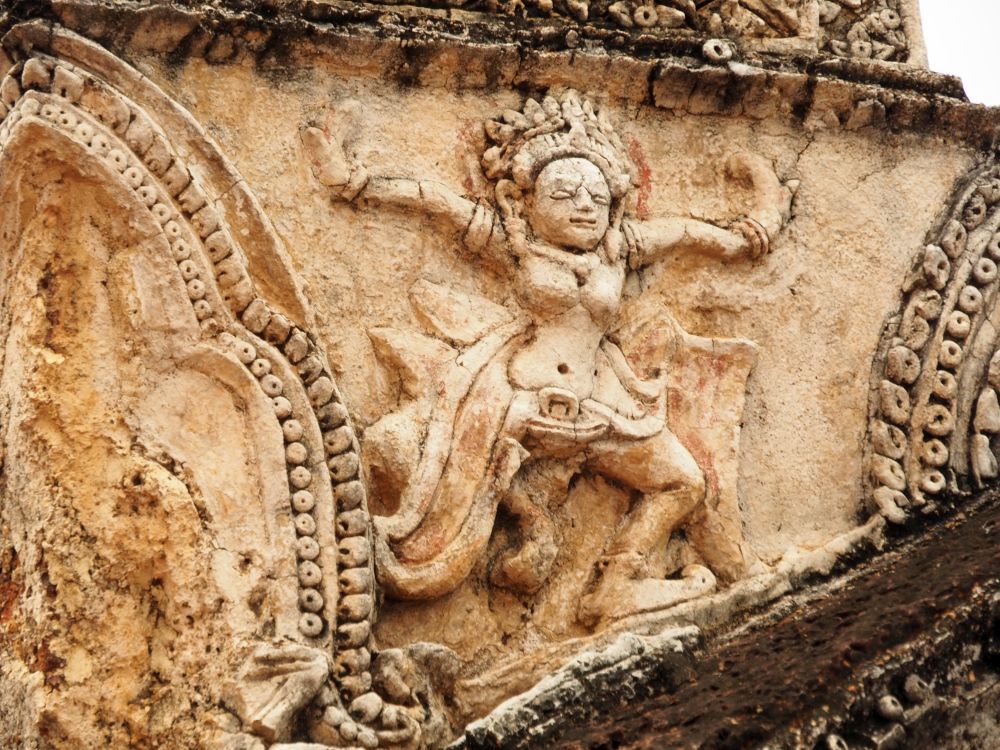
Here’s a tip related to this temple: cross the metal bridge from nearby the temple to the other side of the river. You’ll find a little cafe called Chomprang Si Satchanalai. You’ll have to take off your shoes to go in but you can sit on the balcony overlooking the river and enjoy a delicious piece of cake and a cup of coffee as you admire the view of Wat Phra Si Ratana Mahathat Chaliang.
Wat Chom Chuen
About 400 meters away from Wat Phra Si Ratana Mahathat Chaliang, you’ll find Wat Chom Chuen. There’s a bell-shaped stupa and the remains of an assembly hall and mandapa (open-sided pavilion). These may date from even before the Sukhothai period. Excavations here found burials indicating that this spot was occupied in the 3rd or 4th century, and two brick buildings were found that pre-date the Sukhothai period.
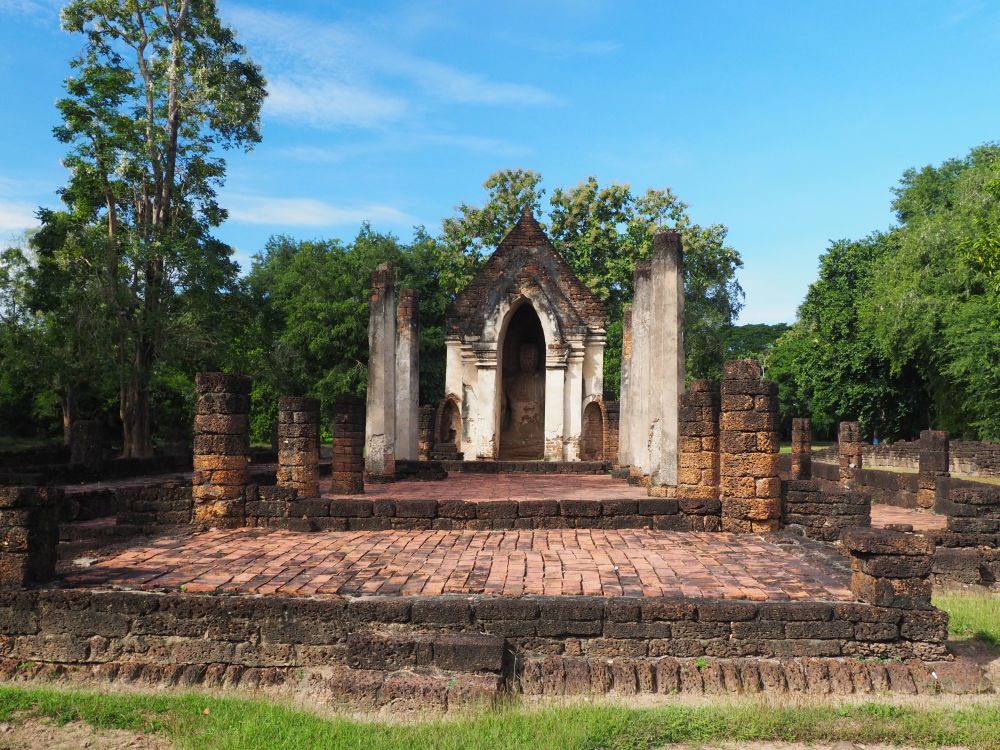
Wat Chao Chan
Not far from Wat Chom Chuen is this small temple that also pre-dates the Sukhothai period. There may have been brick buildings even earlier but the surviving prang dates to the Khmer period before the establishment of the Sukhothai kingdom. You could easily miss several Buddha statues here – they’re so eroded they look like ghosts of themselves.
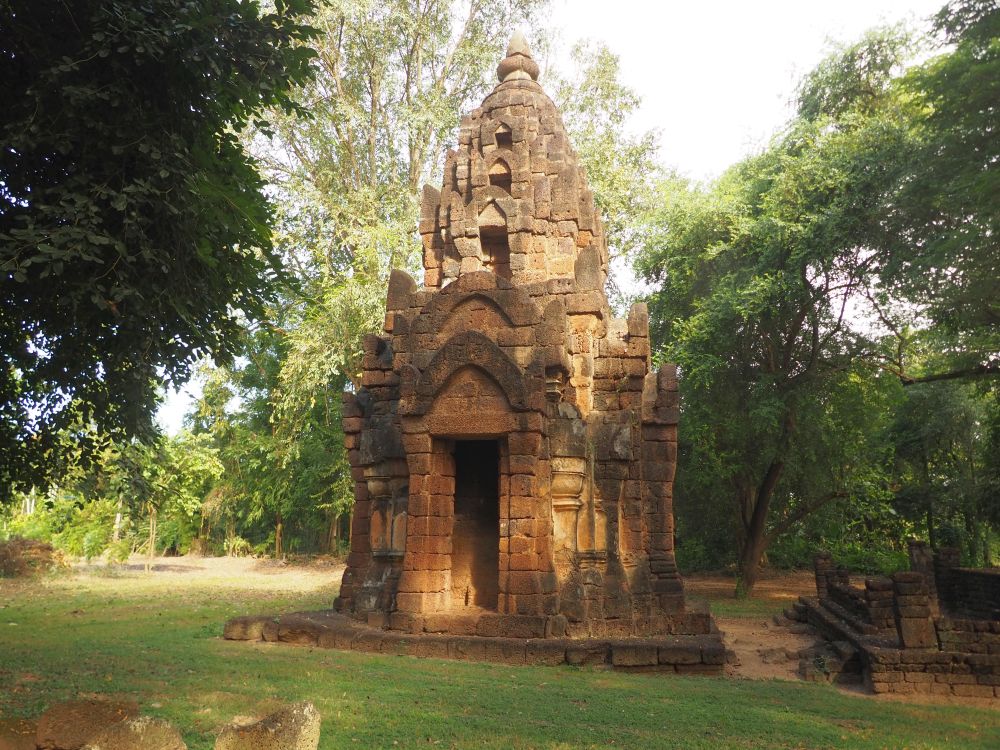
Wat Chang Lom
This temple complex is right in the central zone of the Si Satchanalai park. A pretty temple framed by a green field, it’s special because of the extensive statuary that survives. The central element is a bell-shaped stupa on a square base with, around the base, 39 sculptures of standing elephants. The stucco has mostly worn off and they’ve lost their trunks and tails, so these days they look more like lions or dogs. This design element comes from Sri Lanka and conveys the idea of elephants supporting the earth.
Above the elephants, a smaller level of the base has 20 niches around its sides containing 20 Buddhas in Subduing Mara pose. These have survived better than the elephants, so you can see more detail of the stucco layers.

Wat Chedi Chet Thaeo
This large monastery and temple complex is inside the square walled area next to Wat Chang Lom. It has 33 stupas in various styles including the main one which has the lotus-bud shape on a square base. The subordinate smaller stupas are in neat rows. It includes the remains of an assembly hall and several mandapas, which are open-sided halls. Here and there on the stupas, you can spot some surviving stucco work, especially inside of niches.
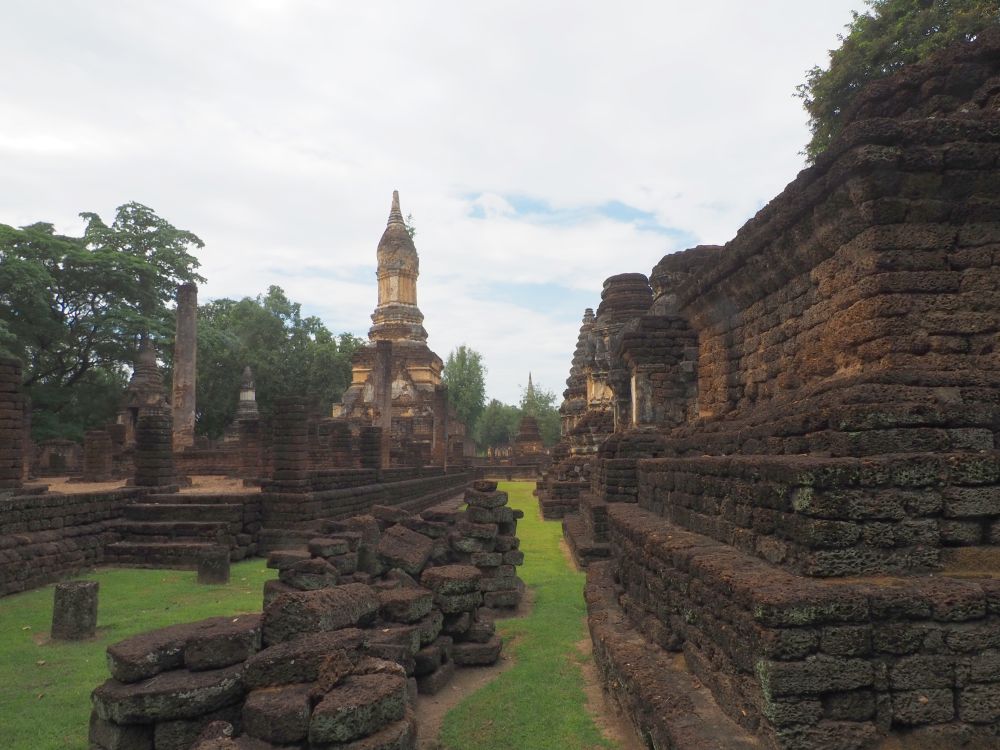
Notice, in a niche in the main stupa, a figure of a sitting Buddha on top of a coiled snake: a Naga Buddha in meditation pose.
What is a Naga Buddha?
The story behind this Buddha image is that the Buddha, after he attained enlightenment, was meditating under a bodhi tree – he is depicted in meditation pose, with both hands, palms upward, in his lap. After weeks of meditation, it began to rain hard. The king of serpents, Mucilanda, came and protected the Buddha by raising him from the wet ground on his coils while his seven heads formed a shelter over his head.
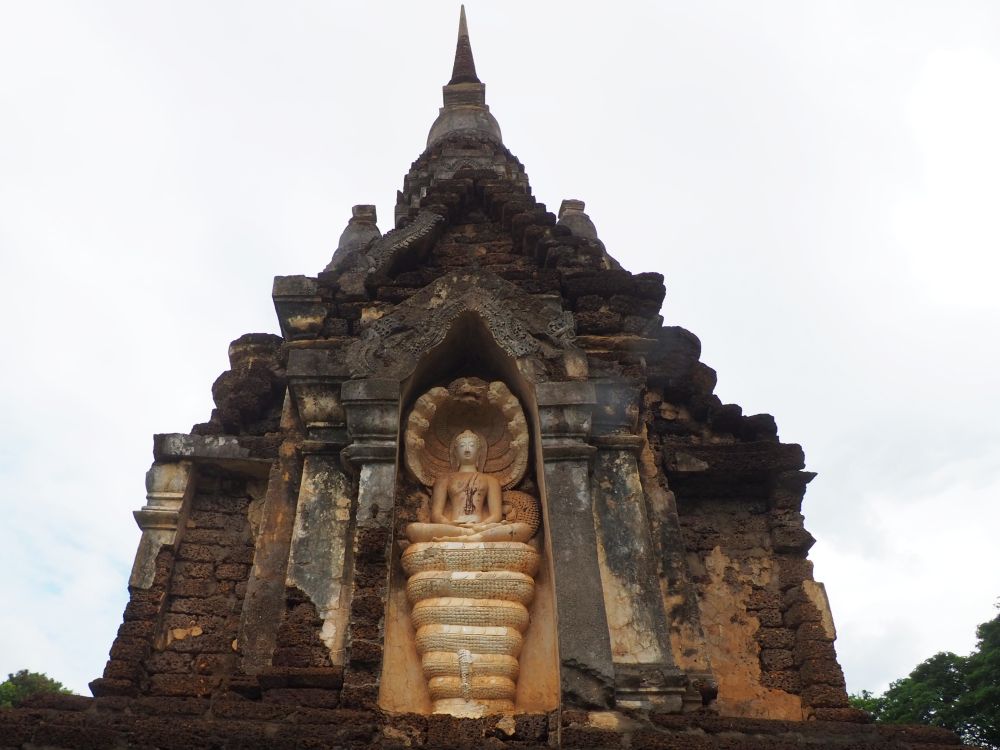
Wat Nang Phaya
Also inside the wall, not far from Wat Chedi Chet Thaeo and Wat Chang Lom, this complex is a good one to get a sense for what an assembly hall might have once looked like. Walk along the still-standing wall and you’ll see some detailed stucco in flowery designs. They date from the Ayutthaya period.
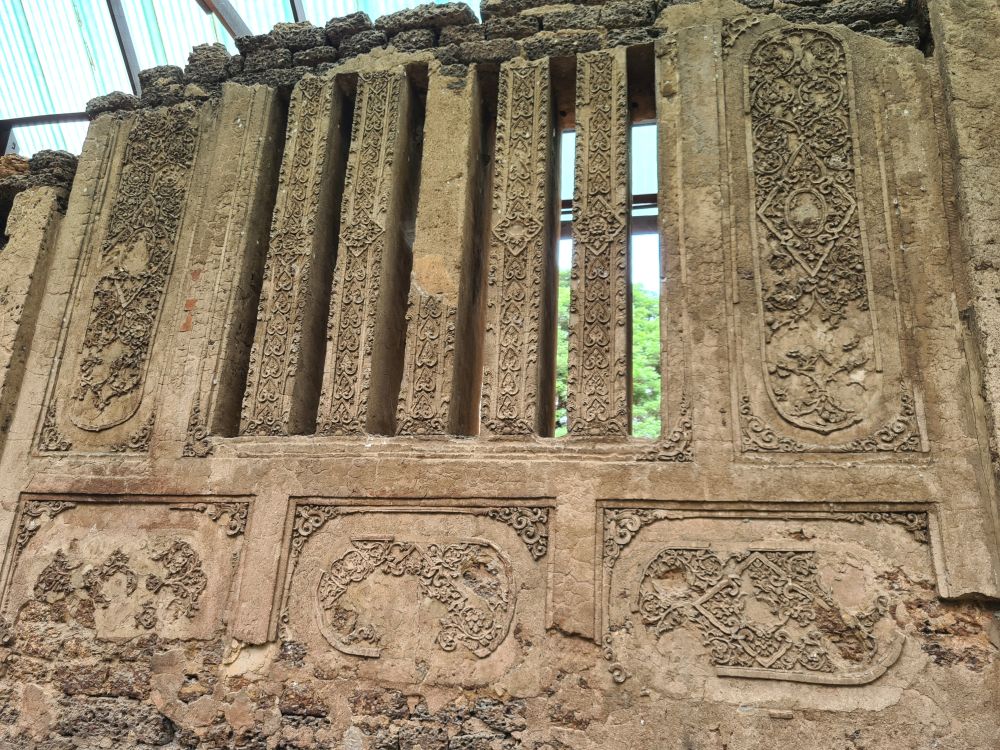
Wat Khao Phanom Phloeng
Here you can climb 114 laterite steps to a bell-shaped stupa and the remains of a seated Buddha in Subduing Mara pose.

There are plenty more monuments to see inside the Si Satchanalai Historical Park, but these are the most important ones. If you’re short on time, at least see the museum, Wat Phra Si Ratana Mahathat Chaliang, Wat Chang Lom, and Wat Chedi Chet Thaeo. Like at Sukhothai, it’s best to use a rented bike if you want to see more of the park, although at this park you can also use a car to get around.
Kamphaeng Phet Historical Park
I didn’t get to visit this historical park about an hour south of Sukhothai. Originally Kamphaeng Phet served as a defensive outpost – anyone attacking from the south would come to this fortified city first, before reaching Sukhothai. It had city walls around a rectangular town area. However, some parts of the park are quite far out of that center – up to 18 kilometers away. Most of the structures are of laterite stone.
The park has three separate parts. The original fortified town is called Khet Nai. It has a beautiful and quite big reclining Buddha backed by two equally large sitting Buddhas. At Khet Nai you can also see the remaining laterite walls and moat as well as forts and gates that are in decent shape.
Khet Aranyik is a section outside of the original town that was a monastery. It’s where you’ll find the remains of a reclining Buddha as well as a stupa with 68 stucco elephants and a nine-meter-high standing Buddha.
What does a reclining Buddha mean?
Reclining Buddhas represent the moments just before the Buddha died and reached Nirvana. Since he had already achieved enlightenment in his lifetime, he could enter Nirvana upon his death, which was supposedly caused by eating bad pork. Buddhists believe that those who have achieved enlightenment escape the cycle of reincarnation.
The third section (Mueang Nakhon Chum) is across the river. It’s older and in worse shape, with temple ruins just scattered over a large area, not set up for visitors and largely ignored. However, Nakhon Chum is home to the only historical Buddhist temple in the park that is still active today, Wat Phra Borommathat, though it is much changed from its original design.
Ayutthaya or Sukhothai?
The temples, stupas, prangs and other remaining structures at Ayutthaya are generally larger; the complexes were bigger and the towers are taller. It’s also in somewhat better condition, in general. That’s not surprising because most of it is at least a century newer. Also, because of its proximity to Bangkok, it’s still used as a place of worship much more than Sukhothai. There are many newer and still active temples around Ayutthaya.
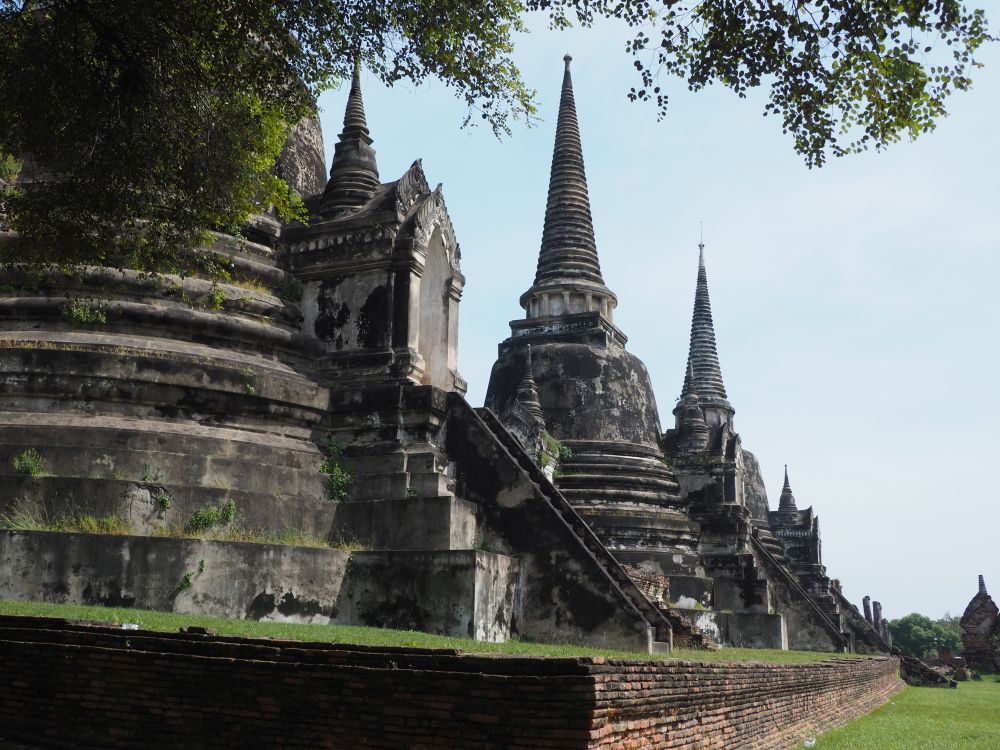
Of course, all of this also means that Ayutthaya has become a very important tourist attraction for Thailand. It can be crowded, and tourists arrive by the busload. Sukhothai isn’t crowded. As a matter of fact, we saw very few people at Sukhothai Historical Park and even fewer at Si Satchanalai Historical Park.
If the history of Thailand interests you, you’ll get a fuller picture by visiting both former capitals. Ayutthaya is easier to get to though, so travel will have to be part of your calculation.
Admission to Sukhothai
While you can see temples from a distance as you drive the outskirts of Sukhothai national park, you’ll need to pay admission to see the ruins of Sukhothai up close. The price isn’t high though – there are five zones that have separate charges, but you can buy a pass to all of them for under the equivalent of $10. Si Satchanalai charges a similar fee. Kamphaeng Phet is cheaper, and you only have to pay to see the original fortified town. The other two parts of the historical park are freely accessible.
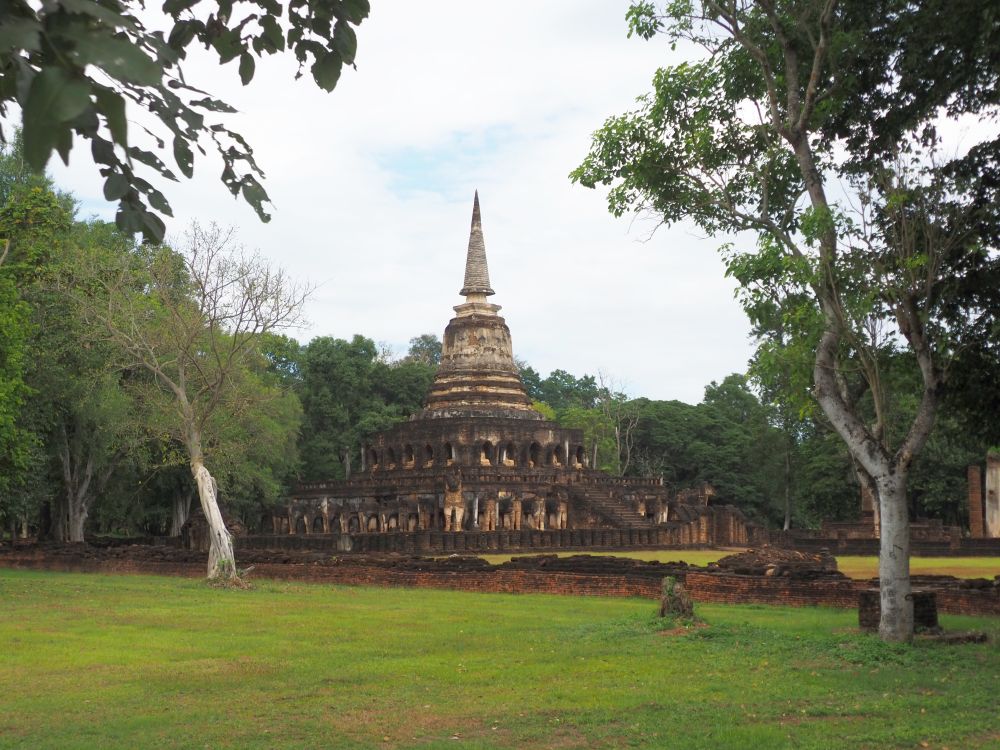
Where to stay in Sukhothai?
New Sukhothai is a modern Thai city, and there are plenty of accommodation options either there or nearer to old Sukhothai where the Sukhothai ruins are. I stayed at Thai Thai Sukhothai resort about a mile from the historical park. I had a nice big clean room with air conditioning and a bathroom for a very good price. The “resort” seems to encompass several buildings in a residential area. It served a good breakfast in a pleasant open-air space in a building around the block from my room.
If you’re in town just to see the historical sites, I’d suggest doing the same: stay near the historic town of Sukhothai. Then do day trips to one or both of the other sites.
Book accommodations in Sukhothai.
Where is Sukhothai?
Sukhothai is about a six-hour drive north of Bangkok; halfway to Chiang Mai. I got there on a cheap Bangkok Air flight, which takes an hour from Bangkok’s Suvarnabhumi Airport to Sukhothai’s absolutely charming little airport. The problem with flying is that there are no flights between Sukhothai and Chiang Mai. If you’re trying to see both, you’ll have to go back down to Bangkok and take another flight from there. Otherwise you can take a bus to Chiang Mai.
If you’re traveling over land to get between Bangkok and Chiang Mai, Sukhothai is a good place to stop. If you’re going out of your way to see it, flying makes more sense and is quite cheap.
None of the three parts of this UNESCO site is reachable by train. You can take a train to the town of Phitsanulok in under seven hours, then take a one-hour bus ride to Sukhothai. There’s also an overnight train where you can book a sleeper berth. Book well ahead.
There are plenty of buses from Bangkok to New Sukhothai (about 7-8 hours) and also between Sukhothai and Si Satchanalai and Kamphaeng Phet. You’ll end up having to take a taxi, tuk tuk or songthaew (an open-backed truck with seats) to the historical site from the bus station in each new city.
If you’d rather not have to puzzle over getting from place to place, sign up for a multi-day tour!
My travel recommendations
Planning travel
- Skyscanner is where I always start my flight searches.
- Booking.com is the company I use most for finding accommodations. If you prefer, Expedia offers more or less the same.
- Discover Cars offers an easy way to compare prices from all of the major car-rental companies in one place.
- Use Viator or GetYourGuide to find walking tours, day tours, airport pickups, city cards, tickets and whatever else you need at your destination.
- Bookmundi is great when you’re looking for a longer tour of a few days to a few weeks, private or with a group, pretty much anywhere in the world. Lots of different tour companies list their tours here, so you can comparison shop.
- GetTransfer is the place to book your airport-to-hotel transfers (and vice-versa). It’s so reassuring to have this all set up and paid for ahead of time, rather than having to make decisions after a long, tiring flight!
- Buy a GoCity Pass when you’re planning to do a lot of sightseeing on a city trip. It can save you a lot on admissions to museums and other attractions in big cities like New York and Amsterdam.
Other travel-related items
- It’s really awkward to have to rely on WIFI when you travel overseas. I’ve tried several e-sim cards, and GigSky’s e-sim was the one that was easiest to activate and use. You buy it through their app and activate it when you need it. Use the code RACHEL10 to get a 10% discount!
- Another option I just recently tried for the first time is a portable wifi modem by WifiCandy. It supports up to 8 devices and you just carry it along in your pocket or bag! If you’re traveling with a family or group, it might end up cheaper to use than an e-sim. Use the code RACHELSRUMINATIONS for a 10% discount.
- I’m a fan of SCOTTeVEST’s jackets and vests because when I wear one, I don’t have to carry a handbag. I feel like all my stuff is safer when I travel because it’s in inside pockets close to my body.
- I use ExpressVPN on my phone and laptop when I travel. It keeps me safe from hackers when I use public or hotel wifi.
